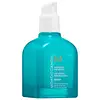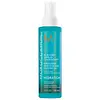What's inside
What's inside
 Key Ingredients
Key Ingredients

 Benefits
Benefits

 Concerns
Concerns

 Ingredients Side-by-side
Ingredients Side-by-side

Water
Skin ConditioningDimethicone
EmollientGlycerin
HumectantCyclohexasiloxane
EmollientHydroxyethyl Acrylate/Sodium Acryloyldimethyl Taurate Copolymer
Emulsion StabilisingSqualane
EmollientArgania Spinosa Kernel Oil
EmollientHydrolyzed Quinoa
Skin ConditioningHydrolyzed Adansonia Digitata Seed Extract
Camellia Sinensis Leaf Extract
AntimicrobialChamomilla Recutita Flower Extract
MaskingLavandula Angustifolia Flower Extract
CleansingParfum
MaskingCoconut Alkanes
EmollientPEG-40 Castor Oil
EmulsifyingGalactoarabinan
Polysorbate 60
EmulsifyingDilinoleic Acid/Propanediol Copolymer
EmollientSorbitan Isostearate
EmulsifyingBenzophenone-4
UV AbsorberPanthenol
Skin ConditioningCoco-Caprylate/Caprate
EmollientXylitol
HumectantEthyl Macadamiate
Skin ConditioningCitric Acid
BufferingBenzophenone-3
UV AbsorberTocopherol
AntioxidantMalic Acid
BufferingSulfuric Acid
BufferingPotassium Sorbate
PreservativeSodium Benzoate
MaskingBenzyl Alcohol
PerfumingPhenoxyethanol
PreservativeWater, Dimethicone, Glycerin, Cyclohexasiloxane, Hydroxyethyl Acrylate/Sodium Acryloyldimethyl Taurate Copolymer, Squalane, Argania Spinosa Kernel Oil, Hydrolyzed Quinoa, Hydrolyzed Adansonia Digitata Seed Extract, Camellia Sinensis Leaf Extract, Chamomilla Recutita Flower Extract, Lavandula Angustifolia Flower Extract, Parfum, Coconut Alkanes, PEG-40 Castor Oil, Galactoarabinan, Polysorbate 60, Dilinoleic Acid/Propanediol Copolymer, Sorbitan Isostearate, Benzophenone-4, Panthenol, Coco-Caprylate/Caprate, Xylitol, Ethyl Macadamiate, Citric Acid, Benzophenone-3, Tocopherol, Malic Acid, Sulfuric Acid, Potassium Sorbate, Sodium Benzoate, Benzyl Alcohol, Phenoxyethanol
Water
Skin ConditioningCetearyl Alcohol
EmollientPropanediol
SolventCetyl Alcohol
EmollientArgania Spinosa Kernel Oil
EmollientHelianthus Annuus Seed Oil
EmollientHordeum Vulgare Seed Extract
Skin ConditioningParfum
MaskingHydrolyzed Rice Protein
Skin ConditioningHydrolyzed Quinoa
Skin ConditioningWheat Amino Acids
Skin ConditioningSoy Amino Acids
Skin ConditioningCitric Acid
BufferingGlucose
HumectantGlycerin
HumectantDimethicone
EmollientCaprylic/Capric Triglyceride
MaskingBehentrimonium Methosulfate
Stearamine Oxide
CleansingOlealkonium Chloride
Behentrimonium Chloride
PreservativeAmodimethicone
Isopropyl Alcohol
SolventCaprylic/Capric Glycerides Polyglyceryl-10 Esters
EmollientXylitylglucoside
HumectantGuar Hydroxypropyltrimonium Chloride
Skin ConditioningAnhydroxylitol
HumectantGlyceryl Stearate Se
EmulsifyingCinnamidopropyltrimonium Chloride
Xylitol
HumectantTrideceth-12
EmulsifyingPolyquaternium-7
Polyquaternium-11
C12-13 Pareth-9
EmulsifyingCetrimonium Chloride
AntimicrobialArginine Hcl
Skin ConditioningSerine
MaskingThreonine
Algin
MaskingChitosan
Potassium Sorbate
PreservativeSodium Benzoate
MaskingBenzyl Alcohol
PerfumingPhenoxyethanol
PreservativeWater, Cetearyl Alcohol, Propanediol, Cetyl Alcohol, Argania Spinosa Kernel Oil, Helianthus Annuus Seed Oil, Hordeum Vulgare Seed Extract, Parfum, Hydrolyzed Rice Protein, Hydrolyzed Quinoa, Wheat Amino Acids, Soy Amino Acids, Citric Acid, Glucose, Glycerin, Dimethicone, Caprylic/Capric Triglyceride, Behentrimonium Methosulfate, Stearamine Oxide, Olealkonium Chloride, Behentrimonium Chloride, Amodimethicone, Isopropyl Alcohol, Caprylic/Capric Glycerides Polyglyceryl-10 Esters, Xylitylglucoside, Guar Hydroxypropyltrimonium Chloride, Anhydroxylitol, Glyceryl Stearate Se, Cinnamidopropyltrimonium Chloride, Xylitol, Trideceth-12, Polyquaternium-7, Polyquaternium-11, C12-13 Pareth-9, Cetrimonium Chloride, Arginine Hcl, Serine, Threonine, Algin, Chitosan, Potassium Sorbate, Sodium Benzoate, Benzyl Alcohol, Phenoxyethanol
 Reviews
Reviews

Ingredients Explained
These ingredients are found in both products.
Ingredients higher up in an ingredient list are typically present in a larger amount.
You may know this ingredient as argan oil. Argan Oil has antioxidant, hydrating, and soothing properties.
Studies have shown argan oil can help fight again radical damage from the sun. This makes it effective at preventing hyperpigmentation.
Large amounts of vitamin E found in argan oil helps the skin retain water. Argan oil also contains fatty acids such as linoleic acid, oleic acid, and palmitic acid. It is also a good source of lipids.
Another benefit of argan oil is skin-soothing. It can help reduce inflammation-related skin symptoms.
Argan Oil is effective at regulating sebum production in pores. This can make it effective at treating hormonal acne.
Traditionally, argan oil was used for its antibacterial and antifungal properties. However, argan oil contains fatty acids that may make it not fungal-acne safe.
Argan Trees are native to Morocco.
Learn more about Argania Spinosa Kernel OilBenzyl Alcohol is most commonly used as a preservative. It also has a subtle, sweet smell. Small amounts of Benzyl Alcohol is not irritating and safe to use in skincare products. Most Benzyl Alcohol is derived from fruits such as apricots.
Benzyl Alcohol has both antibacterial and antioxidant properties. These properties help lengthen the shelf life of products. Benzyl Alcohol is a solvent and helps dissolve other ingredients. It can also improve the texture and spreadability.
Alcohol comes in many different forms. Different types of alcohol will have different effects on skin. This ingredient is an astringent alcohol.
Using high concentrations of these alcohols are drying on the skin. They may strip away your skin's natural oils and even damage your skin barrier. Astringent alcohols may also irritate skin.
Other types of astringent alcohols include:
According to the National Rosacea Society based in the US, you should be mindful of products with these alcohols in the top half of ingredients.
Any type of sanitizing product will have high amounts of alcohol to help kill bacteria and viruses.
Learn more about Benzyl AlcoholCitric Acid is an alpha hydroxy acid (AHA) naturally found in citrus fruits like oranges, lemons, and limes.
Like other AHAs, citric acid can exfoliate skin by breaking down the bonds that hold dead skin cells together. This helps reveal smoother and brighter skin underneath.
However, this exfoliating effect only happens at high concentrations (20%) which can be hard to find in cosmetic products.
Due to this, citric acid is usually included in small amounts as a pH adjuster. This helps keep products slightly more acidic and compatible with skin's natural pH.
In skincare formulas, citric acid can:
While it can provide some skin benefits, research shows lactic acid and glycolic acid are generally more effective and less irritating exfoliants.
Most citric acid used in skincare today is made by fermenting sugars (usually from molasses). This synthetic version is identical to the natural citrus form but easier to stabilize and use in formulations.
Read more about some other popular AHA's here:
Learn more about Citric AcidDimethicone is a type of synthetic silicone created from natural materials such as quartz.
What it does:
Dimethicone comes in different viscosities:
Depending on the viscosity, dimethicone has different properties.
Ingredients lists don't always show which type is used, so we recommend reaching out to the brand if you have questions about the viscosity.
This ingredient is unlikely to cause irritation because it does not get absorbed into skin. However, people with silicone allergies should be careful about using this ingredient.
Note: Dimethicone may contribute to pilling. This is because it is not oil or water soluble, so pilling may occur when layered with products. When mixed with heavy oils in a formula, the outcome is also quite greasy.
Learn more about DimethiconeGlycerin is already naturally found in your skin. It helps moisturize and protect your skin.
A study from 2016 found glycerin to be more effective as a humectant than AHAs and hyaluronic acid.
As a humectant, it helps the skin stay hydrated by pulling moisture to your skin. The low molecular weight of glycerin allows it to pull moisture into the deeper layers of your skin.
Hydrated skin improves your skin barrier; Your skin barrier helps protect against irritants and bacteria.
Glycerin has also been found to have antimicrobial and antiviral properties. Due to these properties, glycerin is often used in wound and burn treatments.
In cosmetics, glycerin is usually derived from plants such as soybean or palm. However, it can also be sourced from animals, such as tallow or animal fat.
This ingredient is organic, colorless, odorless, and non-toxic.
Glycerin is the name for this ingredient in American English. British English uses Glycerol/Glycerine.
Learn more about GlycerinWe don't have a description for Hydrolyzed Quinoa yet.
Parfum is a catch-all term for an ingredient or more that is used to give a scent to products.
Also called "fragrance", this ingredient can be a blend of hundreds of chemicals or plant oils. This means every product with "fragrance" or "parfum" in the ingredients list is a different mixture.
For instance, Habanolide is a proprietary trade name for a specific aroma chemical. When used as a fragrance ingredient in cosmetics, most aroma chemicals fall under the broad labeling category of “FRAGRANCE” or “PARFUM” according to EU and US regulations.
The term 'parfum' or 'fragrance' is not regulated in many countries. In many cases, it is up to the brand to define this term.
For instance, many brands choose to label themselves as "fragrance-free" because they are not using synthetic fragrances. However, their products may still contain ingredients such as essential oils that are considered a fragrance by INCI standards.
One example is Calendula flower extract. Calendula is an essential oil that still imparts a scent or 'fragrance'.
Depending on the blend, the ingredients in the mixture can cause allergies and sensitivities on the skin. Some ingredients that are known EU allergens include linalool and citronellol.
Parfum can also be used to mask or cover an unpleasant scent.
The bottom line is: not all fragrances/parfum/ingredients are created equally. If you are worried about fragrances, we recommend taking a closer look at an ingredient. And of course, we always recommend speaking with a professional.
Learn more about ParfumPhenoxyethanol is a preservative that has germicide, antimicrobial, and aromatic properties. Studies show that phenoxyethanol can prevent microbial growth. By itself, it has a scent that is similar to that of a rose.
It's often used in formulations along with Caprylyl Glycol to preserve the shelf life of products.
Potassium Sorbate is a preservative used to prevent yeast and mold in products. It is commonly found in both cosmetic and food products.
This ingredient comes from potassium salt derived from sorbic acid. Sorbic acid is a natural antibiotic and effective against fungus.
Both potassium sorbate and sorbic acid can be found in baked goods, cheeses, dried meats, dried fruit, ice cream, pickles, wine, yogurt, and more.
You'll often find this ingredient used with other preservatives.
Learn more about Potassium SorbateSodium Benzoate is a preservative. It's used in both cosmetic and food products to inhibit the growth of mold and bacteria. It is typically produced synthetically.
Both the US FDA and EU Health Committee have approved the use of sodium benzoate. In the US, levels of 0.1% (of the total product) are allowed.
Sodium benzoate works as a preservative by inhibiting the growth of bacteria inside of cells. It prevents the cell from fermenting a type of sugar using an enzyme called phosphofructokinase.
It is the salt of benzoic acid. Foods containing sodium benzoate include soda, salad dressings, condiments, fruit juices, wines, and snack foods.
Studies for using ascorbic acid and sodium benzoate in cosmetics are lacking, especially in skincare routines with multiple steps.
We always recommend speaking with a professional, such as a dermatologist, if you have any concerns.
Learn more about Sodium BenzoateWater. It's the most common cosmetic ingredient of all. You'll usually see it at the top of ingredient lists, meaning that it makes up the largest part of the product.
So why is it so popular? Water most often acts as a solvent - this means that it helps dissolve other ingredients into the formulation.
You'll also recognize water as that liquid we all need to stay alive. If you see this, drink a glass of water. Stay hydrated!
Learn more about WaterXylitol is a humectant and prebiotic. It can help with dry skin.
In studies, xylitol has been shown to improve dry skin. It decreased transepidermal water loss, or when water passes through the skin and evaporates. Xylitol also showed to help improve the biomechanical properties of the skin barrier.
The prebiotic property of xylitol may also help reinforce our skin's natural microbiome. Having a healthy microbiome prevents infection by bad bacteria and helps with hydration.
As a humectant, Xylitol helps draw moisture from both the air and from deeper skin layers. This helps keep skin hydrated.
Xylitol is a sugar alcohol and commonly used as a sugar substitute. It is naturally occurring in plants such as strawberries and pumpkin.
Learn more about Xylitol